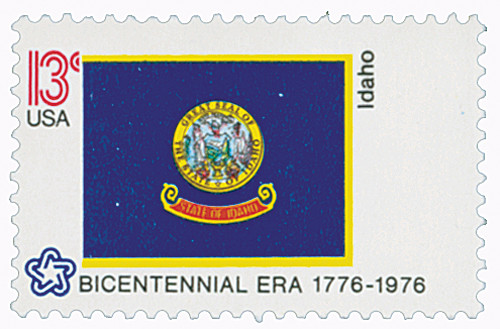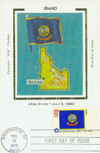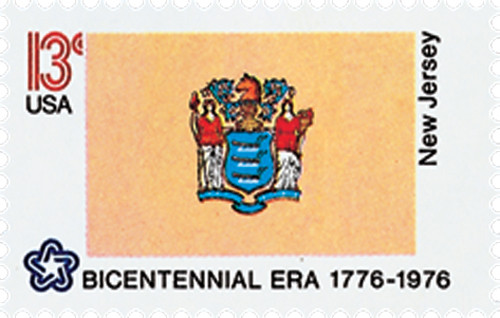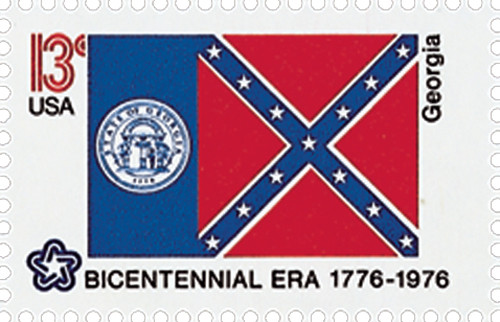
# 1675 - 1976 13c State Flags: Idaho
U.S. 1675
1976 Idaho
State Flags
American Bicentennial Series
• First time a sheet 50 had all different stamp designs
• Part of the American Bicentennial Series
Stamp Category: Commemorative
Series: American Bicentennial Series
Value: 13¢ First-class postage rate
First Day of Issue: February 23, 1976
First Day City(s): Washington, DC
Quantity Issued: 8,720,100 (panes of 50)
Printed by: Bureau of Engraving and Printing
Printing Method: Photogravure
Format: Sheet of 50
Perforations: 11
Why the stamp was issued:
The United States Postal Service celebrated the American Bicentennial with a full pane of the Union’s fifty state flags.
About the stamp design:
The Idaho State Flag was first flown in 1898 during the Spanish-American War as the banner of the First Idaho Volunteer Infantry. The flag was presented by the women of the state to the regiment, who carried it for the duration of their service. In 1907, the flag was adopted as the official flag of Idaho, in a gesture honoring service of the First Idaho Volunteer Infantry. At the center of a blue field is the Great Seal of the State of Idaho. Within the seal are a woman (representing liberty), a miner, and other symbols honoring the state’s rich history in forestry, farming, mining, and wildlife.
About the printing process:
Printed by the Bureau of Engraving and Printing on their seven-color Andreotti gravure press (601) which was their work horse for multicolored stamps.
About the American Bicentennial Series:
In the 1970s, America celebrated its 200th anniversary with hundreds of national events commemorating the heroes and historic events that led to our nation’s independence from Great Britain. The U.S. Postal Service issued 113 commemorative stamps over a six-year period in honor of the U.S. bicentennial, beginning with the American Revolution Bicentennial Commission Emblem stamp (U.S. #1432). As a group, the Bicentennial Series chronicles one of our nation’s most important chapters, and remembers the events and patriots who made the U.S. a world model for liberty.
Several of the stamps honored colonial life – craftsmen and communication. Other stamps honored important battles including Lexington and Concord, Bunker Hill, and Saratoga. Significant events such as the Boston Tea Party, the meeting of the First Continental Congress, and the Declaration of Independence were featured as well. The stamps also honored many significant people such as George Washington, Sybil Ludington, Salem Poor, and the Marquis de Lafayette.
Many of the stamps feature classic artwork. For instance, the set of four souvenir sheets picture important events recreated by noted artists such as John Trumbull. The Bicentennial Series also includes an important US postal first – the first 50-stamp se-tenant – featuring all 50 state flags. The format proved to be popular with collectors, and has been repeated many times since.
The American Bicentennial Series is packed with important US history – it tells the story of our nation’s fight for independence through stamps.
History the stamp represents:
On July 3, 1890, Idaho was admitted as America’s 43rd state.
Experts believe American Indians lived in the Idaho region more than 10,000 years ago. Idaho tribes included the Coeur d’Alene, Pend d’Oreille, Kutenai, Paiute, and Bannock. However, the largest tribes were the Nez Percé and Shoshone.
In 1805, members of an expedition, led by the explorers Meriwether Lewis and William Clark, became the first Europeans to reach Idaho. They crossed the Bitterroot Mountains, where they met Shoshone and Nez Percé Indians. The Indians helped the explorers build canoes, which they floated down the Clearwater and Snake rivers into the Columbia River.
In 1809, British explorer David Thompson established a fur trading post on Pend Oreille Lake. In 1834, American Nathaniel Wyeth founded Fort Hall, and Thomas McKay of the British Hudson’s Bay Company founded Fort Boise. Presbyterian missionaries Henry and Eliza Spalding traveled to Idaho. Eliza was one of the first white women to travel by land to the Northwest.
In 1855, a group of Mormons began farming in eastern Idaho. They built Fort Lemhi and the state’s first irrigation projects before they were driven away by Indians. Another group of Mormons arrived in 1860 and established Franklin, Idaho’s first permanent settlement.
Idaho’s population grew rapidly after E. D. Pierce discovered gold in Orofino Creek in 1860. In 1862, George Grimes discovered gold in the Boise Basin. Towns grew rapidly as prospectors poured into the area.
The Idaho Territory was created on March 4, 1863. Lewiston was named the capital. The territory included all of today’s Idaho and Montana, and most of Wyoming. Montana became a separate territory in 1864, and Wyoming followed in 1868. Boise became Idaho’s capital in 1864.
Railroad construction sped the territory’s growth. Mormons brought the Utah Northern Railroad into Franklin in 1874. In 1884, the Oregon Short Line Railroad linked booming silver mines in Hailey and at the Big Wood River with Oregon.
The growing white population led to conflicts with Indians. When the U.S. Army attempted to settle the Nez Percé Indians on the Lapwai Reservation in Idaho, they resisted. On June 17, 1874, they defeated U.S. troops at the battle of White Bird Canyon in north-central Idaho. The Nez Percé soon retreated, and were captured near the Canadian border.
Suffering from a lack of food, the Bannock Indians left their reservation in 1878. They attempted to dig camas roots on the Prairie, but white settlers claimed this land for their cattle-grazing ground. Fighting ensued, and the Bannock leader, Chief Buffalo Horn, was killed. The Bannock then broke into smaller groups, which were eventually captured.
On July 3, 1890, Idaho achieved statehood. The state’s first major challenge came quickly, when disputes between union and nonunion miners, as well as mine owners, erupted into violence during the 1890s. The union miners were members of the Western Federation of Miners, the chief union in the Industrial Workers of the World, a radical labor organization. In 1892, the Coeur d’Alene region became particularly violent. Union miners fought nonunion miners and mine owners with dynamite and guns. The situation degenerated again in 1899. Idaho governor Frank Steunenberg was forced to declare martial law and called for federal troops.
U.S. 1675
1976 Idaho
State Flags
American Bicentennial Series
• First time a sheet 50 had all different stamp designs
• Part of the American Bicentennial Series
Stamp Category: Commemorative
Series: American Bicentennial Series
Value: 13¢ First-class postage rate
First Day of Issue: February 23, 1976
First Day City(s): Washington, DC
Quantity Issued: 8,720,100 (panes of 50)
Printed by: Bureau of Engraving and Printing
Printing Method: Photogravure
Format: Sheet of 50
Perforations: 11
Why the stamp was issued:
The United States Postal Service celebrated the American Bicentennial with a full pane of the Union’s fifty state flags.
About the stamp design:
The Idaho State Flag was first flown in 1898 during the Spanish-American War as the banner of the First Idaho Volunteer Infantry. The flag was presented by the women of the state to the regiment, who carried it for the duration of their service. In 1907, the flag was adopted as the official flag of Idaho, in a gesture honoring service of the First Idaho Volunteer Infantry. At the center of a blue field is the Great Seal of the State of Idaho. Within the seal are a woman (representing liberty), a miner, and other symbols honoring the state’s rich history in forestry, farming, mining, and wildlife.
About the printing process:
Printed by the Bureau of Engraving and Printing on their seven-color Andreotti gravure press (601) which was their work horse for multicolored stamps.
About the American Bicentennial Series:
In the 1970s, America celebrated its 200th anniversary with hundreds of national events commemorating the heroes and historic events that led to our nation’s independence from Great Britain. The U.S. Postal Service issued 113 commemorative stamps over a six-year period in honor of the U.S. bicentennial, beginning with the American Revolution Bicentennial Commission Emblem stamp (U.S. #1432). As a group, the Bicentennial Series chronicles one of our nation’s most important chapters, and remembers the events and patriots who made the U.S. a world model for liberty.
Several of the stamps honored colonial life – craftsmen and communication. Other stamps honored important battles including Lexington and Concord, Bunker Hill, and Saratoga. Significant events such as the Boston Tea Party, the meeting of the First Continental Congress, and the Declaration of Independence were featured as well. The stamps also honored many significant people such as George Washington, Sybil Ludington, Salem Poor, and the Marquis de Lafayette.
Many of the stamps feature classic artwork. For instance, the set of four souvenir sheets picture important events recreated by noted artists such as John Trumbull. The Bicentennial Series also includes an important US postal first – the first 50-stamp se-tenant – featuring all 50 state flags. The format proved to be popular with collectors, and has been repeated many times since.
The American Bicentennial Series is packed with important US history – it tells the story of our nation’s fight for independence through stamps.
History the stamp represents:
On July 3, 1890, Idaho was admitted as America’s 43rd state.
Experts believe American Indians lived in the Idaho region more than 10,000 years ago. Idaho tribes included the Coeur d’Alene, Pend d’Oreille, Kutenai, Paiute, and Bannock. However, the largest tribes were the Nez Percé and Shoshone.
In 1805, members of an expedition, led by the explorers Meriwether Lewis and William Clark, became the first Europeans to reach Idaho. They crossed the Bitterroot Mountains, where they met Shoshone and Nez Percé Indians. The Indians helped the explorers build canoes, which they floated down the Clearwater and Snake rivers into the Columbia River.
In 1809, British explorer David Thompson established a fur trading post on Pend Oreille Lake. In 1834, American Nathaniel Wyeth founded Fort Hall, and Thomas McKay of the British Hudson’s Bay Company founded Fort Boise. Presbyterian missionaries Henry and Eliza Spalding traveled to Idaho. Eliza was one of the first white women to travel by land to the Northwest.
In 1855, a group of Mormons began farming in eastern Idaho. They built Fort Lemhi and the state’s first irrigation projects before they were driven away by Indians. Another group of Mormons arrived in 1860 and established Franklin, Idaho’s first permanent settlement.
Idaho’s population grew rapidly after E. D. Pierce discovered gold in Orofino Creek in 1860. In 1862, George Grimes discovered gold in the Boise Basin. Towns grew rapidly as prospectors poured into the area.
The Idaho Territory was created on March 4, 1863. Lewiston was named the capital. The territory included all of today’s Idaho and Montana, and most of Wyoming. Montana became a separate territory in 1864, and Wyoming followed in 1868. Boise became Idaho’s capital in 1864.
Railroad construction sped the territory’s growth. Mormons brought the Utah Northern Railroad into Franklin in 1874. In 1884, the Oregon Short Line Railroad linked booming silver mines in Hailey and at the Big Wood River with Oregon.
The growing white population led to conflicts with Indians. When the U.S. Army attempted to settle the Nez Percé Indians on the Lapwai Reservation in Idaho, they resisted. On June 17, 1874, they defeated U.S. troops at the battle of White Bird Canyon in north-central Idaho. The Nez Percé soon retreated, and were captured near the Canadian border.
Suffering from a lack of food, the Bannock Indians left their reservation in 1878. They attempted to dig camas roots on the Prairie, but white settlers claimed this land for their cattle-grazing ground. Fighting ensued, and the Bannock leader, Chief Buffalo Horn, was killed. The Bannock then broke into smaller groups, which were eventually captured.
On July 3, 1890, Idaho achieved statehood. The state’s first major challenge came quickly, when disputes between union and nonunion miners, as well as mine owners, erupted into violence during the 1890s. The union miners were members of the Western Federation of Miners, the chief union in the Industrial Workers of the World, a radical labor organization. In 1892, the Coeur d’Alene region became particularly violent. Union miners fought nonunion miners and mine owners with dynamite and guns. The situation degenerated again in 1899. Idaho governor Frank Steunenberg was forced to declare martial law and called for federal troops.


















